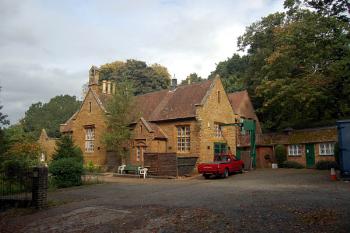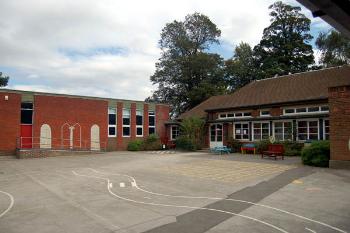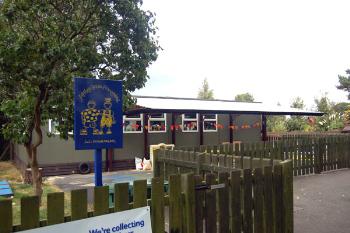Aspley Guise School

mosaic on the wall of Aspley Guise Lower School September 2007
A national enquiry took place in 1846/7 when the Church of England sought to obtain information on all its church schools. This was against the background of a new Whig government which championed secular education and the increasing importance of nonconformists, particularly Wesleyan Methodist, and Roman Catholics in providing schools. The return for Aspley Guise noted that "it was proposed to apply for assistance towards building a school to be placed in connection with the National Society". As a result Aspley Guise National School was built in 1848 in Woburn Lane. In 1850 an inspector stated that the education for the 213 pupils could be better but "The master is a very respectable and conscientious man. I also think well of the intelligence and industry of the Mistress"; his main criticism was that the teaching was mechanical and that discipline had to be improved. In 1853 an inspection report recorded that 107 juniors and 65 infants were present and that: "organisation, discipline, methods and instruction" were good. By 1856, however, the school was being criticised for its attendance - the average for the year being 113 with the average days per year attended by each child being just 133.768.
The first Education Act was passed in 1870 (more correctly it was known as the Elementary Education Act). It was a milestone in the provision of education in Britain demonstrating central government's unequivocal support for education of all classes across the country. It also sought to secularise education by allowing the creation of School Boards. These were groups of representatives, elected by the local ratepayers and the Board had the powers to raise funds to form a local rate to support local education, build and run schools, pay the fees of the poorest children, make local school attendance compulsory between the ages of 5 and 13 and could even support local church schools, though in practice they replaced them, turning them into Board run schools (known as Board Schools).

Aspley Guise Board School about 1900 [Z818/35]
A School Board was created for Aspley Guise in 1879; to reflect this the school became known as Aspley Guise Board School. The school logbook entry for November 14th 1879 illustrates one of the effects of this change: "the new scale of fees came into operation on Monday, several children have left in consequence of the higher fees charged for those coming from other parishes". [SDAspleyGuise1/1]
The logbooks also show what the children were being taught. For example lessons for the infants in 1888-9 were to include recitations, object lessons – including: "natural phenomenon. Snow, hail, rain, thunder and lightening, sun". Lessons for the Mixed Department would include learning poetry such as Gray’s Elegy. [SDAspleyGuise1/1] There were treats too, as on 17th July 1896 when ‘school work has been hindered this week by Sunday school and Band of Hope Festivals’.
The school received ‘boarded out’ children from London Union workhouses. In 1894 there were objections because it was felt that the school was becoming overcrowded and that their behaviour meant discipline was getting worse. This was disputed by the Committee who believed that there was more than enough room and that the inspector’s reports from the previous year gave no cause for concern on the subject of discipline.

the former Aspley Guise School in September 2007
A land mark Education Act was passed in 1902, coming into effect in 1903. It disbanded the School Boards and gave day to day running of education to newly formed Local Education Authorities, usually the county council, as in Bedfordshire. The old Board Schools thus became Council Schools whilst the old National, British and other non-Board schools became known as Public Elementary Schools. Aspley Guise Board School thus became Aspley Guise Council School. Bedfordshire & Luton Archives & Records Service possesses a volume of School Inspector's Reports for most Bedfordshire schools for a few years before World War One and then for the inter war years [E/IN1/1]. In 1911 the inspector reported that the senior division was "fairly satisfactory" but that the reading and writing of the juniors needed to "considerably improve"; the infants were "quite satisfactorily taught". Two years later it was reported that "considerable improvement has been effected" with seniors and juniors and infants were "as usual…kindly, carefully and very well taught".
In 1921 it was reported that "It is some years since a report was furnished upon this School and during the interval war conditions and the difficulty in obtaining staff have affected it; also the numbers have diminished"; pronunciation of words was particularly bad it being noted "it is seldom easy and often difficult to follow the children without referring to the book which they are reading", the inspector was obviously not familiar with the Bedfordshire dialect! It was hoped that the present staff were permanent and improvement maintained. A brief report in 1925 noted the illness of the headmaster and of his anxiety to improve the school in every way. In 1928 it was noted that the junior school was a pleasure to visit, two new staff having fitted in very well, the singing, in particular was described as remarkable. The final surviving report, for 1932/3 described the heating as ineffective (visits were on 28 December and 27 January!) the temperatures mostly being in the 40s Farenheit, once as low as 31. The only remark about the school other than the temperature was "The work is promising under the present Head Teacher who has not been here very long".

Aspley Guise Lower School September 2007
The Council School moved to its current premises in Spinney Lane in 1940. The old school is now a private house and light industrial unit. As well as moving premises, there were other changes during the Second World War. The school logbook entry for 14th Sept 1939 says that ‘Children were evacuated from the London area. The Walthamstow seniors were sent here. The greater number of evacuated senior girls and boys were billeted in this area with their respective staffs. Our director decided that we should work together as one school. As there is not sufficient room in our school, it was suggested that we use the Parish Hall as an extra room.’ They borrowed trestle tables and chairs to make the room useable. (Ref: SD Aspley Guise 1/4)
The Attendance Book 1942-3 shows that children came to Aspley Guise from Walthamstow, London City Councils, Kent, Essex, East Ham, Newhaven and East Sussex. An insert shows that in 1940 there were 81 evacuated children and 62 children who normally lived in Aspley Guise registered with the school [SDAspley Guise7/1].

Playground and rear of Aspley Guise Lower School Sep 2007
The third of the great Education Acts was that of 1944 which established the principle of County Primary Schools for children up to the age of 11, at which time they took an examination to determine the nature of the secondary school they would attend until they were 15, the most academically able going to grammar schools, the rest to secondary or secondary modern schools. The act also created two types of successor to the public elementary schools - the Voluntary Aided and Voluntary Controlled schools. Voluntary Aided schools are those in which the Local Education Authority funds the school but the governing body is independent, they are usually Anglican or Roman Catholic schools. Voluntary Controlled schools own their own buildings whilst the staff are employed directly by the governors. Aspley Guise school duly became a County Primary School
In the 1970s Bedfordshire County Council introduced comprehensive education, doing away with the 11+ examination and grammar schools and introducing a tier of school between the old County Primary and County Secondary Schools. Thus Lower Schools now taught children aged 4 to 9, Middle Schools from 9 to 13 and Upper Schools from 13 onwards. Aspley Guise school is now a Lower School

Aspley Guise Pre-School Sep 2007
A pre-school also exists at Aspley Guise. It is on the school premises, to one side of the playground in a temporary classroom which has replaced an earlier temporary classroom which used to be part of the County Primary School. The pre-school accepts children from two years old.